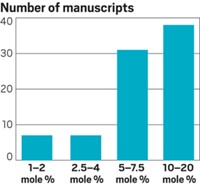Advertisement
Grab your lab coat. Let's get started
Welcome!
Welcome!
Create an account below to get 6 C&EN articles per month, receive newsletters and more - all free.
It seems this is your first time logging in online. Please enter the following information to continue.
As an ACS member you automatically get access to this site. All we need is few more details to create your reading experience.
Not you? Sign in with a different account.
Not you? Sign in with a different account.
ERROR 1
ERROR 1
ERROR 2
ERROR 2
ERROR 2
ERROR 2
ERROR 2
Password and Confirm password must match.
If you have an ACS member number, please enter it here so we can link this account to your membership. (optional)
ERROR 2
ACS values your privacy. By submitting your information, you are gaining access to C&EN and subscribing to our weekly newsletter. We use the information you provide to make your reading experience better, and we will never sell your data to third party members.
Synthesis
Catalyst acidity sets enantioselectivity
May 21, 2007
| A version of this story appeared in
Volume 85, Issue 21
Efforts to design better asymmetric catalysts that rely on hydrogen bonding to activate their substrates will get a leg up from a new study of the effect of catalyst acidity on such reactions (Angew. Chem. Int. Ed., DOI: 10.1002/anie.200700298). Hydrogen bonding, a common mode of substrate activation in enzymes, only recently has been exploited in synthetic asymmetric catalysts. Hoping to better understand the role hydrogen bonding plays in these reactions, Matthew S. Sigman and Katrina H. Jensen of the University of Utah systematically compared the activity of oxazoline catalysts of varying acidity in a hydrogen-bond-catalyzed hetero-Diels-Alder reaction between a diene and benzaldehyde. They found that both the reaction rate and the enantioselectivity are linearly correlated to the catalyst's acidity. That enantioselectivity directly tracks catalyst acidity "is especially exciting because it provides the basis for the design of new asymmetric catalysts," the researchers note. They're now working to determine what gives rise to this effect.





Join the conversation
Contact the reporter
Submit a Letter to the Editor for publication
Engage with us on Twitter